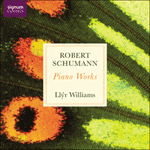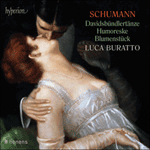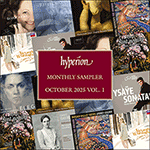
Welcome to Hyperion Records, a British classical label devoted to presenting high-quality recordings of music of all styles and from all periods from the twelfth century to the twenty-first.
Hyperion offers both CDs, and downloads in a number of formats. The site is also available in several languages.
Please use the dropdown buttons to set your preferred options, or use the checkbox to accept the defaults.
In each and every time
joy and grief go hand in hand:
keep faith in times of joy
and meet grief with courage.
The Davidsbündlertänze were inscribed to Walther von Goethe, a grandson of the great writer, but no one could be in any doubt that the music was addressed to Clara. The opening bars, clearly labelled ‘Motto by C W’, quote the start of a mazurka from her Soirées musicales, Op 6 (Schumann also began to sketch out an entire piece based on her theme), and Schumann confessed that the pieces were more urgently dedicated to her than anything else he had composed. In offering to send her the Davidsbündlertänze together with his Op 12 Fantasiestücke early in 1838, Schumann told her: ‘There are many wedding thoughts in the dances—they arose in the most beautiful state of excitement I can ever recall.’ And a few weeks later, he explained: ‘The whole story is a Polterabend, and now you can imagine it all from beginning to end.’ (A ‘Polterabend’ is a party held on the eve of a wedding, when crockery is smashed outside the door of the bride’s parents to bring luck to the young couple.)
The ‘Davidsbund’ had been dreamed up by Schumann in his role as a music critic: an army of progressively minded artists dedicated to fighting the conservatives. His Carnaval, Op 9, had ended with a ‘March of the Davidsbündler against the Philistines’; and Schumann had toyed with the idea of calling his Études symphoniques, Op 13, ‘Zwölf Davidsbündleretüden’. In later years he reacted against such fanciful titles: when, in 1842, he first thought of revising the Davidsbündlertänze, he contemplated replacing their name with ‘Zwölf Charakterstücke’ (though whether he intended so radically to reduce the number of pieces in the work is unclear). When he eventually carried out his revision, in 1850/1, the name of ‘Davidsbündler’ was allowed to stand, but the provocative suffix of ‘Tänze’ was dropped: there were, after all, very few dance-like pieces in the collection.
Together with the change in title, the second edition added metronome markings and eliminated some of the earlier version’s more fanciful performance directions. The evocative ‘Etwas hahnbüchen’ (‘somewhat clumsily’) of the third piece, for instance, was replaced by a more prosaic ‘Mit Humor’; and the ‘Sehr rasch und in sich hinein’ (‘very quickly and inwardly’) of No 6 was shortened to ‘Sehr rasch’—a heading that does not conjure up quite so vividly the sense of breathless agitation the performer needs to convey. Schumann’s revision also altered many details in the music itself, introducing, in particular, internal repeats in several of the numbers in order to make them more symmetrical, and more easily absorbed by the listener. Many pianists prefer to retain at least some aspects of the original 1837 version.
Like all of Schumann’s piano cycles, the Davidsbündlertänze have more than one tonal centre. The main focus is on the keys of G major and B minor, and yet each of the two books into which the work is divided ends with a piece in C major. In the first edition the pieces in question carried a superscription. The first of them (No 9) was headed ‘Hereupon Florestan stopped, and his lips quivered painfully’. The quivering was symbolized in the original ending of the piece, where the last note of the concluding phrase was suddenly stripped of its harmony, leaving the note C hanging for an instant in isolation. After this, two understated C major chords dropping through an octave brought this first half of the work to a nervous close. The unfulfilled striving towards C seemed to represent a yearning for Clara, and this was a further detail that Schumann no longer felt necessary to express in 1850: the revised edition allowed the final phrase to resolve conventionally in a fully harmonized C major, and the two concluding chords were eliminated.
The second appearance of C major, at the end of the work, comes as still more of a surprise. The music’s true conclusion is clearly the penultimate number, in B major, which grows out of the preceding piece (these are the only two pieces in the work that are linked together in this fashion), before it eventually recapitulates the cycle’s second number. The entire penultimate piece is played ‘as if from afar’, lending the music a patina of nostalgia. None of this, however, prevented Schumann from adding his C major postscript—a gentle waltz whose simplicity is infinitely affecting. As it draws towards its close, the music begins to fade away with the chimes of midnight sounding deep in the bass. The inscription Schumann placed at the head of this piece in the original edition tells its own story: ‘Quite superfluously Eusebius added the following; but in so doing, much happiness radiated from his eyes.’
from notes by Misha Donat © 2017
En tout temps
Joie et peine vont de pair:
Garde-toi pur dans la joie
Et sois courageux dans le malheur.
Les Davidsbündlertänze furent dédiées à Walther von Goethe, petit-fils du grand écrivain, mais personne ne pouvait douter le moins du monde que la musique s’adressait à Clara. Les premières mesures, avec la mention bien précise «Motto von C W», citent le début d’une mazurka des Soirées musicales, op.6, de Clara (Schumann commença aussi à esquisser une pièce complète basée sur ce thème de Clara), et il avoua que ces pièces lui étaient plus instamment destinées que tout ce qu’il avait composé par ailleurs. En proposant de lui envoyer les Davidsbündlertänze avec ses Fantasiestücke, op.12, au début de l’année 1838, Schumann lui dit: «Dans les danses, il y a beaucoup de motifs qui font rêver au mariage—ils ont pris naissance dans les plus beaux moments d’excitation dont j’ai souvenir.» Et quelques semaines plus tard, il expliqua: «C’est un Polterabend. Tu n’as qu’à imaginer le début et la fin de l’histoire» (un «Polterabend» est une fête à la veille des noces, où on brise de la vaisselle devant la porte des parents de la future mariée pour porter chance au jeune couple).
Le «Davidsbund» avait été conçu par Schumann dans son rôle de critique musical: une armée d’artistes à l’esprit progressiste dévoués à la lutte contre les conservateurs. Son Carnaval, op.9, se terminait par une «Marche des Davidsbündler contre les Philistins»; et Schumann avait joué avec l’idée d’appeler ses Études symphoniques, op.13, «Zwölf Davidsbündleretüden». Plus tard, il changea d’attitude à propos de titres aussi fantaisistes: lorsque, en 1842, il pensa pour la première fois à réviser les Davidsbündlertänze, il envisagea de remplacer leur nom par «Zwölf Charakterstücke» (mais on ignore s’il avait l’intention de réduire de façon aussi radicale le nombre de pièces de cette œuvre). Quand il effectua sa révision, en 1850/51, il conserva le nom de «Davidsbündler» mais supprima le suffixe provocant de «Tänze»: après tout, il y avait très peu de pièces en forme de danses dans le recueil.
Avec le changement de titre, la seconde édition s’enrichit d’indications métronomiques et vit disparaître certaines instructions plus fantaisistes de la première version sur la manière de les jouer. Par exemple, l’évocateur «Etwas hahnbüchen» («avec gaucherie») de la troisième pièce fut remplacé par un plus prosaïque «Mit Humor»; et le «Sehr rasch und in sich hinein» («très rapide et intérieurement») du nº 6 fut raccourci à «Sehr rasch»—intitulé qui n’évoque pas de façon aussi frappante l’impression d’agitation fébrile que l’interprète doit communiquer. La révision de Schumann modifia également de nombreux détails dans la musique elle-même, introduisant, en particulier, des reprises internes dans plusieurs numéros afin de les rendre plus symétriques et plus faciles à assimiler par l’auditeur. Beaucoup de pianistes préfèrent conserver au moins certains aspects de la version originale de 1837.
Comme tous les cycles de musique pour piano de Schumann, les Davidsbündlertänze ont plus d’un centre tonal. Il s’agit surtout des tonalités de sol majeur et si mineur, et pourtant chacun des deux livres qui composent cette œuvre s’achève par une pièce en ut majeur. Dans la première édition, les pièces en question portaient une sorte d’en-tête. La première d’entre elles (nº 9) se composait de l’inscription «Sur ce, Florestan s’arrêta, et un douloureux frisson passa sur ses lèvres». Le frisson était symbolisé dans la fin originale de la pièce, où la dernière note de la phrase conclusive était soudain vidée de son harmonie, laissant un do seul, suspendu pendant un instant. Ensuite, deux accords discrets d’ut majeur descendant d’une octave menaient cette première moitié de l’œuvre à une conclusion tendue. Cette quête insatisfaite de l’ut majeur semblait représenter une aspiration vers Clara et c’est un autre détail que Schumann ne jugeait plus nécessaire d’exprimer en 1850: l’édition révisée permettait à la dernière phrase de se résoudre de manière conventionnelle dans un ut majeur entièrement harmonisé, et les deux derniers accords furent éliminés.
La deuxième apparition d’ut majeur, à la fin de l’œuvre, est encore plus surprenante. La véritable conclusion de la musique est clairement l’avant-dernier numéro, en si majeur, qui naît de la pièce précédente (ce sont les deux seules pièces de l’œuvre qui s’enchaînent de cette manière), avant de finir par réexposer le deuxième numéro du cycle. Toute l’avant-dernière pièce est jouée «comme venant de loin», ce qui prête à la musique une aura de nostalgie. Mais rien de tout cela n’empêcha Schumann d’ajouter son post-scriptum en ut majeur—une douce valse dont la simplicité est infiniment touchante. Quand elle se dirige vers sa conclusion, la musique commence à décliner, le carillon de minuit sonnant dans l’extrême grave. L’inscription que Schumann a placée en tête de cette pièce dans l’édition originale raconte sa propre histoire: «Eusebius ajouta encore ceci, c’était bien superflu; mais, ce faisant, ses yeux étaient remplis de félicité.»
extrait des notes rédigées par Misha Donat © 2017
Français: Marie-Stella Pâris
In all’ und jeder Zeit
Verknüpft sich Lust und Leid;
Bleibt fromm in Lust und seyd
Dem Leid mit Muth bereit.
Die Davidsbündlertänze wurden Walther von Goethe gewidmet, einem Enkel des großen Dichters; doch stand es außer Frage, dass die Musik Clara zugedacht war. Die ersten Takte, bezeichnet mit „Motto von C W“, zitieren den Beginn einer Mazurka aus ihren Soirées musicales, op. 6 (es existiert sogar die Skizze eines ganzen Satzes über dieses Thema), und Schumann bekannte, dass keines seiner bisherigen Werke ihr inniger gewidmet sei als diese Stücke. Als er ihr im Frühjahr 1838 versprach, ihr die Davidsbündlertänze zusammen mit seinen Fantasiestücken, op. 12, zuzusenden, schrieb er ihr: „In den Tänzen sind viele Hochzeitsgedanken—sie sind in der schönsten Erregung entstanden, wie ich mich nur je besinnen kann.“ Und wenige Wochen darauf erklärte er: „Ein ganzer Polterabend nämlich ist die Geschichte u. Du kannst Dir nun Anfang und Schluß aus mahlen.“ (Beim Brauch des Polterabends wurde vor dem Elternhaus der Braut Geschirr zerworfen, was dem jungen Paar Glück bringen sollte.)
Den „Davidsbund“ hatte Schumann sich zu seinen Zeiten als Musikkritiker ausgedacht: eine Schar fortschrittlich gesinnter Künstler, die sich dem Kampf gegen die Konservativen verschrieben hatten. Am Schluss seines Carnaval, op. 9, steht ein „Marche des Davidsbündler contre les Philistins“; und bei den Études symphoniques, op. 13, spielte er mit dem Gedanken, sie „Zwölf Davidsbündleretüden“ zu nennen. In späteren Jahren entwickelte er eine Abneigung gegen derlei fantastische Titel: Als er 1842 den Gedanken fasste, die Davidsbündlertänze zu überarbeiten, kam ihm auch die Idee, den Titel durch „Zwölf Charakterstücke“ zu ersetzen (ob er die Zahl der Sätze tatsächlich so stark zusammenstreichen wollte, bleibt unklar). Als er sich 1850/51 dann an die Revisionsarbeit machte, durften die „Davidsbündler“ stehen bleiben; der provokante Wortteil „Tänze“ jedoch wurde gestrichen, denn es gab in der Satzfolge nur sehr wenige tanzartige Stücke.
Doch änderte Schumann in der zweiten Auflage nicht nur den Titel. Er fügte auch Metronomzahlen hinzu und tilgte einige extravagante Vortragsanweisungen. So wurde aus der Anweisung „Etwas hahnbüchen“ im dritten Stück das etwas nüchternere „Mit Humor“, und von „Sehr rasch und in sich hinein“ im sechsten Satz blieb nur „Sehr rasch“ stehen—eine Überschrift, die nun nicht mehr ganz so lebhaft das Gefühl atemloser Erregung andeutete, das der Pianist hier vermitteln muss. Hinzu kamen bei der Überarbeitung viele Detailänderungen, etwa die neu eingetragenen Wiederholungen in manchen Sätzen, die sie regelmäßiger und dem Hörer besser verständlich machen sollten. Viele Pianisten halten sich zumindest teilweise an die Fassung von 1837.
Wie alle Klavierzyklen Schumanns haben die Davidsbündlertänze mehr als eine Zentraltonart. Der Schwerpunkt liegt auf den Tonarten G-Dur und h-Moll; trotzdem endet jeder der beiden Teilbände des Werks mit einem Stück in C-Dur. Im Erstdruck trugen diese beiden Stücke eine Überschrift. Das erste (Nr. 9) war überschrieben: „Hierauf schloss Florestan und es zuckte ihm schmerzlich um die Lippen.“ Im ursprünglichen Schluss wurde das Zucken symbolisiert, indem der Schlusston der Endphrase plötzlich seines Akkords beraubt wurde, sodass die Note C einen Augenblick lang einsam nachklang. Danach brachten zwei trockene C-Dur-Akkorde im fallenden Oktavabstand den ersten Teil des Werkes zu einem nervösen Abschluss. Das unerfüllte Streben nach C stand offenbar für die Sehnsucht nach Clara—weiteres Detail, das Schumann 1850 nicht mehr für notwendig hielt: In der überarbeiteten Fassung darf die Schlussphrase ganz konventionell in ein voll ausgesetztes C-Dur münden, und die beiden Schlussakkorde fielen weg.
Noch überraschender tritt C-Dur zum zweiten Mal am Ende des Werks ein. An ihr eigentliches Ende kommt die Musik in der vorletzten Nummer in H-Dur, die sich aus dem vorangehenden Stück heraus entwickelt (das einzige Mal im Werk, dass zwei Sätze so miteinander verbunden werden), bevor es dann die zweite Nummer des Zyklus’ wieder aufgreift. Der gesamte vorletzte Satz ist „Wie aus der Ferne“ zu spielen, wodurch die Musik eine nostalgische Färbung annimmt. All das hält Schumann jedoch nicht davon ab, seinen Nachsatz in C-Dur hinzuzufügen—einen Walzer von unendlich anrührender Schlichtheit. Gegen Ende beginnt die Musik, allmählich zu verschwinden, während tief im Bass die Glocken Mitternacht schlagen. Der kleine Kommentar, den Schumann über den Satzbeginn schrieb, spricht für sich: „Ganz zum Überfluss meinte Eusebius noch Folgendes: dabey sprach aber viel Seligkeit aus seinen Augen.“
aus dem Begleittext von Misha Donat © 2017
Deutsch: Friedrich Sprondel
 Piano Works, Vol. 1 Piano Works, Vol. 1Llŷr Williams’ long and successful collaboration with Signum Records continues with this survey of Schumann’s piano works, beginning with the early 'Papillons' completed when he was just twenty.» More |
 Schumann: Davidsbündlertänze, Humoreske & Blumenstück Schumann: Davidsbündlertänze, Humoreske & BlumenstückHyperion is thrilled to present the debut studio recording of 2015 Honens Prize Laureate Luca Buratto in an all-Schumann programme: two large-scale masterpieces and an exquisite miniature.» More |
 Fanny Davies & Adela Verne - The complete recordings Fanny Davies & Adela Verne - The complete recordingsOf the few pupils of Clara Schumann to make recordings, Fanny Davies (1861-1934) was by far the most important. She studied for two years with the great pianist and very much saw herself as a disciple. She went on to have a significant career and ...» More |
 Hyperion sampler - October 2025 Vol. 1 Hyperion sampler - October 2025 Vol. 1 |

